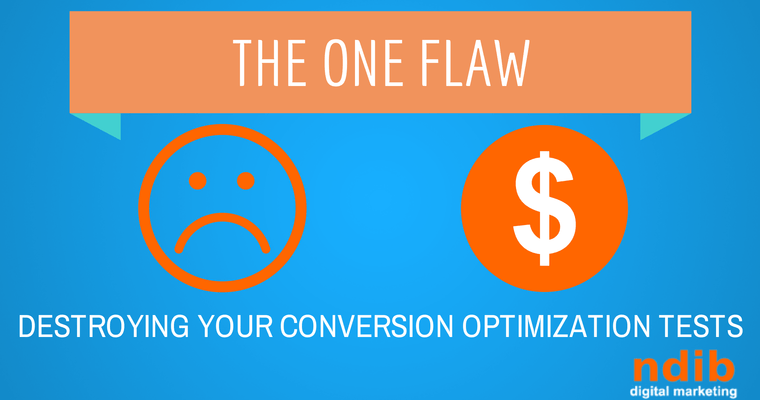Click…..no sale……click……no sale…..click…no sale…
You tensely sit at your desk and watch the data pour in from the first few days of your new conversion optimization campaign. Not good – no sales and no inkling of a winning variant. As the days turn into weeks you feel your blood pressure rise as you stare at the site intently – as though you could simply will conversions to happen. Of course you cannot. Every time the phone rings, you hope it isn’t your client. You would rather receive a call from the IRS than see your client’s number come up. You start to panic because you are spending your client’s money on PPC and labor and are not receiving the conversions you expect. The landing page you spent hours to craft, the ads you carefully analyzed to ensure a high click-through rate, the keywords you agonized over.
None of them convert. You follow best practices and A/B test by the book. Yet as this test runs – neither variant will win. Your client understands the need to learn through testing, they do not look so kindly on just wasting money with no learning outcomes.
As you sip your cold coffee from your lucky mug you go through the conversion optimization process again. It is not a matter of understanding A/B testing – you understand it thoroughly and perform it according to best practice. Why is Amazon able to change a button and make millions? Yet when you change your buttons users don’t even notice. You are frustrated, confused, and ready to give up.
This is your conversion optimization campaign – but it doesn’t have to be this way.
The Flaw: Your Conversion Optimization Variables Are Weaker than Michael Cera

The problem is your conversion tests are weak. You are sheepishly testing elements that don’t really matter and by doing so never have a test that completes. Yes, if you have traffic the likes of Amazon or Bed Bath and Beyond, when you tweak a button it makes a notice difference in conversion rate. With the amount of traffic they have, they could probably change the hue of white in the background of a page and find something out about their customers.
However, if your clients have normal traffic, then testing anything other than the most vital parts of the marketing campaign have little to no impact. Early in my digital marketing career, I had this exact problem. My conversion optimization tests variables included the color of buttons, some very minor text changes and if I was feeling especially spicy I would test different images.
These conversion tests essentially ran forever with no clear winner. I was playing to not lose rather than to win. I needed to get to the crux of the problem and find a way to make my tests strong, test what matters, and have learning outcomes and sales for my clients.
The Solution: Make Your Tests Strong Like Steven Seagal by Testing the Value Proposition

If you read Tim Ferris’s book the 4-Hour Work Week, you know that he is obsessed with the forgotten Italian Economist Vilfredo Pareto. Pareto discovered a rule of nature and economics (creatively called the Pareto rule) that basically states that 20% of the cause governs 80% of the effect. For example, 20% of your customer’s account for 80% of your revenue, 20% of the crops account for 80% of the harvest, and 20% of Urkel’s suspenders account for 80% of his outfits. After reading the Four Hour Work Week, I realized that I needed to find the 20% of variables that affect 80% of my tests.
I began to read books and blogs feverishly looking for the variable. The answer that came up over and over again as the variable to test is the value proposition. A value proposition is basically the perceived value by the customer of what you offer vs. the perceived value of cost the consumer incurs. I was able to become above average at conversion optimization simply by starting my tests with the value proposition as my variable. Here is the tricky part – the perceived costs and the benefits come in many forms. Here are some examples:
Perceived Costs:
- Paying money
- Paying with a tweet
- Providing personal information
- Reading an actual piece of material
- Waiting for a site to load
Perceived Benefits
- Making life easier
- Efficiency
- Fixing a problem
- Status
Testing the value proposition is the number one factor I have found to produce conversions and the learning outcomes that your clients demand (and that you should demand of your agency as well).
How To Find Your Value Proposition to Test
Step One: Talk to Your Client About the Value of Value Proposition
This sounds more Meta than it actually is. The first thing that you want to do is talk to your client about value proposition and why it is so vital. Tell them that this one element can have dramatic effects not only on the actual conversion optimization tests you perform, but can also inform their marketing in many other aspects. Once the conversion optimization tests reveal a highly potent value proposition, the client should feel free to test the winning value proposition in other forms of advertising as well to increase sales.
I have found from experience that sometimes I get initial push back when I suggest we tweak the value proposition. Clients get defensive about their products and services as though changing the value proposition is an attack on the company itself!
The way to get around this hurdle is to explain that the product or service isn’t the problem it is just the way that it is presented. This has everything to do with customer perception, and not the actual quality of their product. Clients also think you are trying to change their slogan – this is not the case. Though a slogan and a value proposition can be the same thing, they are often not.
Step Two: Brainstorm Value Propositions to Test
Single product or services have many different perceived values and costs. It is all perception. For example when buying a car the perceived values could be:
- It is the most economical
- It is a really cool looking car
- It has the best warranty
- It has a sweet sound system to blast Appetite for Destruction
You are going to need to find which of theses are the features and benefits that resonate with your customers. On the other side, a value proposition with all of those features and benefits will sink your campaign, so keep it simple. You want to test one perceived value at a time to see what produces the best result. At some point you may want to start combining, but first, go with one perceived value at a time.
- The first step in brainstorming is to look at the clients website and literally list every feature and benefit. I do this on an excel sheet.
- Next I use a tool (SpyFu – I have no affiliation other than that I use the service and I love it) to go through the competitor’s sites and see the features and benefits that they are promoting. Often I find features and benefits that are surprising and worth testing.
- Talk to your client – Hold a meeting to see if you have captured the important features and benefits.
- You can go to Amazon and look at how customers describe the product.
- Rank them – choose the two most effective.
I talk with my client about the best way to present each value, and together we decide which have the best shot at producing results. I have found that even if the tests are inconclusive, having client buy-in makes your life much easier. Clients like to be involved in the process.
Note: Your value proposition is not just the product – it is often the actual offer. As an example, one of my clients is a luxury real estate company out of Hawaii. I was optimizing their value proposition and looking at the features and the benefits of their actual properties and not seeing any movement in my test. However, when I updated the value proposition of their offer conversions jumped dramatically. The value proposition I changed:
Value Proposition Control:
Cost: User provides information.
Benefit: User gets a call from an agent to provide them more information.
Value Proposition Experiment:
Cost: User provides personal information
Benefit: User gets access to a private video tour
Result: 133% increase in conversions
Additionally, here are some places where you can learn more about value propositions:
- ConversionXL – A great article, with some solid examples
- PPC Hero – I am a bigger fan of PPC Hero than even Shawn Kemp (and that is saying a lot). This Webinar has some good pointers
- MEC Labs – They have a whole course about value propositions
Step Three: Look at the costs
Are there ways to lower the perceived cost? The most common way to lower cost is to look in the forms and see if there are some form fields you can cut. Some of the information is nice to have for marketing, but is it necessary? Do you really need a phone number? Do you really need to know their address? You may – but remember that each of these fields ads to the perceived cost in the customer’s mind.
Step Four: A/B Test
Now that you have client sign off get your test together. A/B testing of your value proposition can be conducted using a variety of programs – I prefer UnBounce because it is easy enough for me to use. Create two versions of a web page or landing page with a different value propositions. Make sure that the value proposition is in a position where it can not be missed. When performing an A/B test make sure the traffic is the same. For example, it is not a valid A/B test if you only send the traffic from an email to one version and the other version is all from natural search.
Step Five: Rinse and Repeat
Just remember: A/B tests are never over! Once you have a winner at a 95% confidence interval, you need to get back on that horse and start a new test. The goal is to keep testing and keep improving. Now that you know the importance of testing your value proposition go and find the right one!
When you perform conversion optimization you want to create strong tests by selecting a variable that provides clear-cut results. If you begin conversion optimization testing by selecting variables like minor text changes or minor tweaks to the shapes of buttons, you risk running weak tests that run forever and never have a clear winner. By testing the value proposition you make your tests strong and move the needle on sales and leads, learn about what customers actually want, and demonstrate the value of conversion optimization to your clients right from the get-go.
What is the one thing that is still preventing you from conversion optimization?
Image Credit
Michael Cera: Ynnil via Flickr (Creative Commons)
Steven Seagal: Gage Skidmore via Wikimedia (Creative Commons)
Featured Image: author created via Canva





